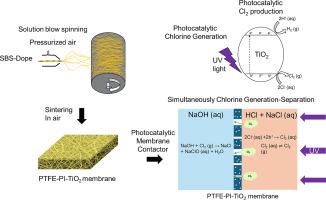Chlorine production from brine using a novel superhydrophobic PTFE-PI-TiO₂ photocatalytic membrane contactor
IF 9.8
1区 工程技术
Q1 ENGINEERING, CHEMICAL
引用次数: 0
Abstract
This study presents a photocatalytic membrane contactor for the simultaneous generation and separation of chlorine gas from acidified brine. This system uses a novel superhydrophobic polyimide-reinforced polytetrafluoroethylene composite membrane containing TiO₂ nanoparticles (PTFE–PI–TiO₂) fabricated via solution blow spinning. Incorporation of polyimide binder with optimal TiO₂ loading yielded hierarchical micro- and nanoscale porous membranes with high porosity (78 to 84 %). Surface wettability analysis demonstrated stable Cassie-Baxter superhydrophobicity up to 15 wt% TiO₂ loading, enabling stable gas-phase transport through membrane pores. Under UV illumination, the PTFE–PI–TiO₂-15 membrane achieved a peak steady-state chlorine generation rate of 19.50 mmol·m−2·h−1 from 35 g L−1 NaCl solution at pH 1. Radical scavenger and EPR studies indicated that chlorine evolution proceeded via direct hole oxidation of chloride ions without radical intermediates. Mass transfer modeling suggests that chlorine flux was governed by surface-exposed photocatalytic activity rather than membrane transport limitations. This work establishes a scalable and energy-efficient approach for chlorine recovery from desalination brine, offering a sustainable solution for brine management and decentralized chemical production.

采用新型超疏水PTFE-PI-TiO 2光催化膜接触器从卤水中制氯
研究了一种光催化膜接触器,用于同时生成和分离酸化盐水中的氯气。该系统采用一种新型的超疏水聚酰亚胺增强聚四氟乙烯复合膜,其中含有二氧化钛纳米粒子(ptfe - pi -二氧化钛)。将聚酰亚胺结合剂与最佳tio2负载相结合,得到了具有高孔隙率(78% ~ 84%)的分层微纳米级多孔膜。表面润湿性分析显示稳定的Cassie-Baxter超疏水性高达15 wt%的tio2负载,实现稳定的气相通过膜孔输送。在紫外光照射下,在35 g L−1 NaCl溶液中,PTFE-PI-TiO₂-15膜在pH为1时的稳态产氯速率峰值为19.50 mmol·m−2·h−1。自由基清除剂和EPR研究表明,氯离子通过直接空穴氧化而不含自由基中间体。传质模型表明,氯通量受表面暴露的光催化活性而不是膜传输限制的控制。这项工作为从海水淡化盐水中回收氯建立了一种可扩展且节能的方法,为盐水管理和分散的化学品生产提供了可持续的解决方案。
本文章由计算机程序翻译,如有差异,请以英文原文为准。
求助全文
约1分钟内获得全文
求助全文
来源期刊

Desalination
工程技术-工程:化工
CiteScore
14.60
自引率
20.20%
发文量
619
审稿时长
41 days
期刊介绍:
Desalination is a scholarly journal that focuses on the field of desalination materials, processes, and associated technologies. It encompasses a wide range of disciplines and aims to publish exceptional papers in this area.
The journal invites submissions that explicitly revolve around water desalting and its applications to various sources such as seawater, groundwater, and wastewater. It particularly encourages research on diverse desalination methods including thermal, membrane, sorption, and hybrid processes.
By providing a platform for innovative studies, Desalination aims to advance the understanding and development of desalination technologies, promoting sustainable solutions for water scarcity challenges.
 求助内容:
求助内容: 应助结果提醒方式:
应助结果提醒方式:


